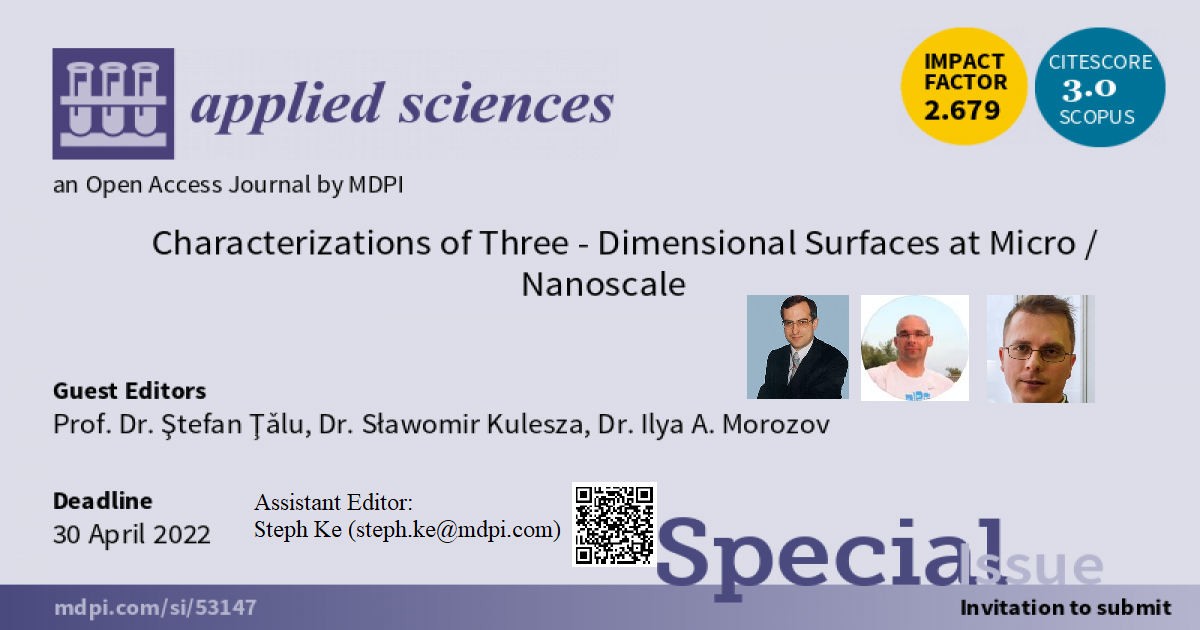Characterizations of Three-Dimensional Surfaces at Micro/Nanoscale
A special issue of Applied Sciences (ISSN 2076-3417). This special issue belongs to the section "Nanotechnology and Applied Nanosciences".
Deadline for manuscript submissions: closed (30 April 2022) | Viewed by 28355

Special Issue Editors
Interests: polymers; nanocomposites; polymeric and biopolymeric particles; topographical and morphological characterization of three-dimensional surfaces at micro/nanoscale; development of new mathematical tools in the investigation of 3D surface quality; theoretic and applied research in advanced materials science in applied sciences; mechanical and tribological characterization of macro–micro–nanostructures; experimental techniques for micro/nanomechanical and micro/nanotribological characterization; fractal and multifractal geometry analysis and applications; molecular dynamics method
Special Issues, Collections and Topics in MDPI journals
Interests: nanostructured materials; thin film deposition; nanomaterials synthesis; material characteristics
Special Issues, Collections and Topics in MDPI journals
Special Issue Information
Dear Colleagues,
The ability to manufacture products of increasingly lower surface roughness for functionally relevant surfaces is a necessity today. For quality assurance and process control, the precise and accurate measurement of three-dimensional (3D) surface topography represents a major technological issue in the science, engineering, and manufacturing industry, for assessing the quality of high-performance micro/nanosurfaces, and in ultraprecision machining. In the modern approach within material science, the characterization of nanometric engineering surfaces based on the application of stereometric, spectral analysis, fractal/multifractal theory, and Minkowsky functionals has remained a challenging task of substantial research. This activity can provide a better understanding of the relationship between surface topography, microstructure, mechanical and physical–chemical properties. Such a research topic involves a multidisciplinary point of view, including knowledge from diverse scientific areas such as scanning microscopy, metrology, and mathematics. This Special Issue covers all aspects of 3D surface characterization techniques, ranging from descriptive statistics, stereometric analysis, spectral analysis, fractal/multifractal theory, and Minkowsky functionals. Studies focusing on the theoretical simulation of the micromorphology, computerized procedures, mathematical algorithms, and optimal research techniques for description of 3D surface of materials at micro/nanoscale are also welcome.
Prof. Dr. Ştefan Ţălu
Dr. Sławomir Kulesza
Dr. Ilya A. Morozov
Guest Editors
Manuscript Submission Information
Manuscripts should be submitted online at www.mdpi.com by registering and logging in to this website. Once you are registered, click here to go to the submission form. Manuscripts can be submitted until the deadline. All submissions that pass pre-check are peer-reviewed. Accepted papers will be published continuously in the journal (as soon as accepted) and will be listed together on the special issue website. Research articles, review articles as well as short communications are invited. For planned papers, a title and short abstract (about 250 words) can be sent to the Editorial Office for assessment.
Submitted manuscripts should not have been published previously, nor be under consideration for publication elsewhere (except conference proceedings papers). All manuscripts are thoroughly refereed through a single-blind peer-review process. A guide for authors and other relevant information for submission of manuscripts is available on the Instructions for Authors page. Applied Sciences is an international peer-reviewed open access semimonthly journal published by MDPI.
Please visit the Instructions for Authors page before submitting a manuscript. The Article Processing Charge (APC) for publication in this open access journal is 2400 CHF (Swiss Francs). Submitted papers should be well formatted and use good English. Authors may use MDPI's English editing service prior to publication or during author revisions.
Keywords
- Topography and morphology of 3D surfaces at micro/nanoscale
- Experimental correlation between surface morphology structure and materials properties (mechanical, optical, physicochemical)
- Topographical and morphological 3D characterization technology: of surfaces: classical and new methods
- Multiscale characterization of surface topography
- 3D surface microtexture
- Stereometric analysis, spectral analysis, fractal/multifractal analysis, and Minkowsky functionals for characterization of surface topography
- Mathematical models of the 3D surface microtexture
- Theoretical studies, computerized simulation, and reconstruction of the 3D micromorphology of surfaces
- Characterization of atomic surface roughness in nanometric machining molecular dynamics simulations
Benefits of Publishing in a Special Issue
- Ease of navigation: Grouping papers by topic helps scholars navigate broad scope journals more efficiently.
- Greater discoverability: Special Issues support the reach and impact of scientific research. Articles in Special Issues are more discoverable and cited more frequently.
- Expansion of research network: Special Issues facilitate connections among authors, fostering scientific collaborations.
- External promotion: Articles in Special Issues are often promoted through the journal's social media, increasing their visibility.
- Reprint: MDPI Books provides the opportunity to republish successful Special Issues in book format, both online and in print.
Further information on MDPI's Special Issue policies can be found here.







